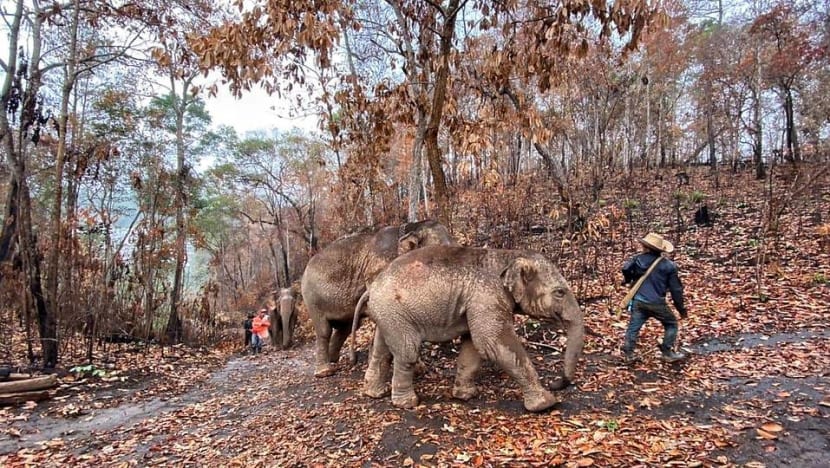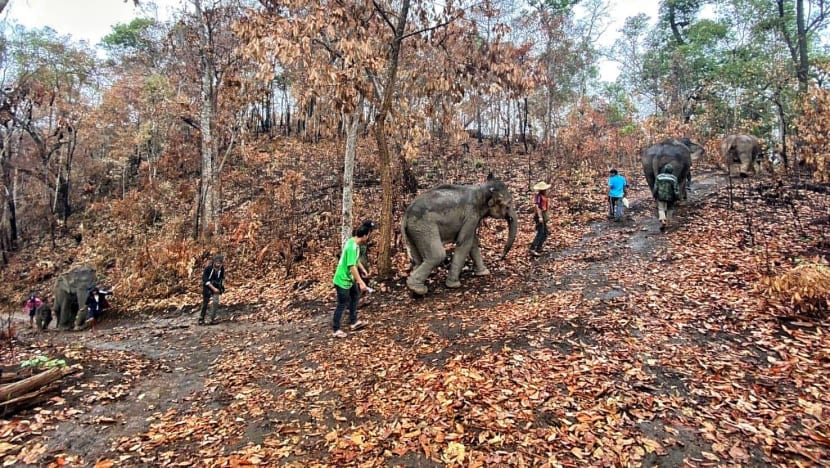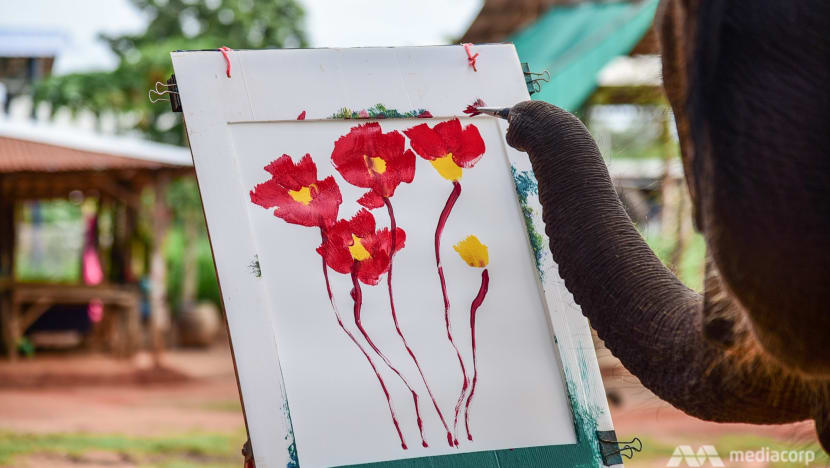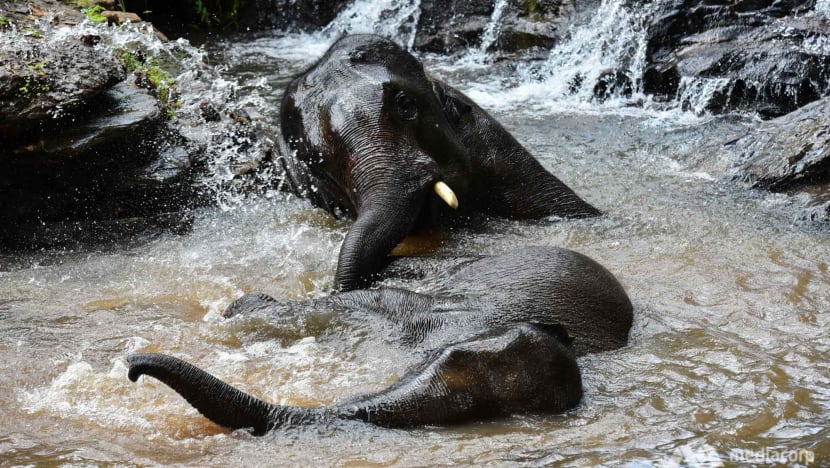COVID-19: Jobless Thai elephants make long trek home as tourists disappear

Caravans of elephants and mahouts have left tourist attractions in Chiang Mai for their home in remote areas of northern Thailand after the COVID-19 pandemic made tourists disappear. (Photo: Save Elephant Foundation)
BANGKOK: Caravans of elephants and mahouts have embarked on a long journey through the hills and forests of northern Thailand.
They would have to walk for days before reaching their native villages in remote areas along the Thai-Myanmar border inhabited by the Karen – an ethnic group with centuries-old tradition of keeping and taming elephants.
It is a journey of uncertainty – both for the tribesmen and their animals left unemployed by the COVID-19 pandemic. Nobody knows if they will be able to return to their old workplace, as dozens of elephant camps which once attracted coachloads of tourists all year round are now shut due to the international travel ban.
“Tourists disappeared when the COVID-19 outbreak started. Everything shut down. Everybody was shocked but not as much as the elephants' owners,” said Sangdeaun ‘Lek’ Chailert, Thailand’s leading animal activist and president of the Save Elephant Foundation.
Located in Chiang Mai, the non-profit organisation provides care and assistance to captive elephants in Thailand through local community outreach, rescue and rehabilitation programmes, as well as ecotourism operations.

Since the pandemic began, the foundation has helped more than 1,500 elephants nationwide with food. Without tourists, the animals risk starvation as their owners have no income and struggle to cope with the expenses.
“The mahouts have to feed their elephants 300kg of food per day,” Lek said.
They don’t have income. They have no money to grow grass. Forest fires have also destroyed their food. So what can they do? They have to go home back in the forest.
It is estimated that there are about 4,400 captive elephants in Thailand. Before the health emergency occurred, more than half of them were working in the tourism industry.
Today, Lek said more than 100 jobless elephants in Chiang Mai alone have walked home, some as young as two months.
Earlier in May, she joined one of the caravans in a five-day trek from elephant camps in Mae Wang district in Chiang Mai to a Karen village in Mae Chaem district near Mae Hong Son.
They walked more than 100km, crisscrossing the jungle and climbing steep hills. Part of their journey involved navigating burnt forests with dead leaves and blackened trees.

Caravans with baby elephants would have to make more stops for the calves to rest and drink milk from their mothers. The animals seemed to enjoy the long walk home, according to Lek.
“They ate food along the way but they were tired as well, especially the old ones and the little babies,” she said.
FROM ASSET TO BURDEN
Captive elephants in Thailand were used to drag timber through thick jungle until 1989, when the government banned logging.
Since then, the animals have become a tourist attraction. Visitors to Thailand often associate them with riding, trekking and circus-like performances as their owners sought new ways to earn money from their animals.
Over the past 30 years, a number of elephant camps have opened across Thailand. Many of them are located in Chiang Mai, a tourism hub in the northern region.

Before the COVID-19 crisis, it would be hard to imagine the province without tourists.
Their absence came as a blow to Thailand’s tourism sector, which greatly relies on international visitors. Earlier this week, the Thai government extended the ban on international arrivals until Jun 30.
Many elephant attractions rent the animals for shows and tourist rides. But since the pandemic made it impossible for the businesses to operate, a number of mahouts have been laid off. Their elephants, once a valuable source of income, are now a heavy burden they struggle to shoulder.
READ: Thai economy slips into recession after worst quarter in 8 years
Thanapat KR, who owns an elephant camp in Ratchaburi, told CNA the economic impact has forced him to lay off most of his employees and advertise his elephants for sale.
“By the end of January, we had zero visitors. I used to have nearly 200 employees but today, only 60-70 people remain and only get paid half of their monthly salary,” he said.
His elephant attraction Changpuak Camp was home to more than 40 elephants prior to the COVID-19 crisis. Today there are 32 left, including 13 elephants that belong to Thanapat.

Despite zero revenue, he has to take care of the animals. Their food costs him more than US$300 every two days. Besides selling all his cars, he is also putting up 10 of his elephants for sale for a total of US$37,500 – a big loss from the original buying price of US$68,700 for all of them.
“People who are interested said I’m selling them at a cheap price but they too face the same economic problem. The animals will only increase their burden,” he told CNA.
“But I need to sell them. If I can’t sell them all at once, I’ll sell them individually. Each of them would keep the business afloat for a month. So 10 elephants mean 10 months. By that time, I should have some income. Otherwise, the business I’ve built up would collapse.”
"THEY’RE SELLING A WHOLE HERD OF ELEPHANTS"
In Thailand, the economic impact of the COVID-19 pandemic is tremendous. For mahouts, however, Lek expects the situation to worsen next month.
“If anyone says the crisis period is March, April and May, it’s not so for elephant owners. The real crisis will hit next month when their savings run out,” she said.

Already, elephant owners have begun selling the animals. Her elephant sanctuary Elephant Nature Park has been approached by many mahouts who keep and drive the animals. They have so far offered to sell her at least 60 elephants.
“An elephant usually costs about US$31,200 or so but currently, some of them can be bought at just US$9,300. The mahouts can’t bear the expenses anymore,” she said.
I’ve never seen anything like this. People are selling a whole herd of elephants.
To help the animals, the Save Elephant Foundation has launched a project to help mahouts grow food. It has called on landowners in various provinces across Thailand to lease empty plots of land to elephant owners at a cheap price.
READ: Beasts of burden: Hooks, chains and pain - How Thailand's elephants have become symbols of despair
READ: Beasts of burden: 'If there’s no blood, how can it be afraid?' - The making and breaking of Thailand's elephants
At the same time, it is also working with ethnic Karen communities in northern Thailand to rebuild their natural environment, transforming deforested areas into sustainable farms and paving the way for ecotourism operations.
Lek hopes it will lead to a brighter future for the communities after the crisis, when men and nature can coexist in harmony and the elephants can live in their natural home.

“Many elephants have returned home after decades in tourism. So I’m trying to ask the mahouts to join a conservation project called Bring Elephants and Their Mahouts Home. This way, they won’t have to leave their village. Instead, they can manage their environment to make it suitable for homestay, and bring tourists there,” Lek said.
Then there will be no need for the elephants to offer rides to tourists or perform in shows. Their owners can take them to the forest, where they can bathe, play in mud and live with nature as part of an ethical tourism programme.
In a remote Karen village in Mae Chaem, jobless elephants and their mahouts received a warm welcome.
The villagers had prepared various kinds of fruits for the animals and sang local songs to mark the special occasion. Some old people wept when they saw the elephants they know return from work at tourist camps for the first time in decades.
“They told me they share some memories together and they were so happy to see the elephants in the village again. They never thought the animals would ever get to come home,” Lek said.
“I’m encouraging elephant owners to restore the natural environment. We’re up against the wall now but we can’t just be sad and wait for donations. We must help ourselves. Stand up and take action.”
BOOKMARK THIS: Our comprehensive coverage of the coronavirus outbreak and its developments
Download our app or subscribe to our Telegram channel for the latest updates on the coronavirus outbreak: https://cna.asia/telegram














